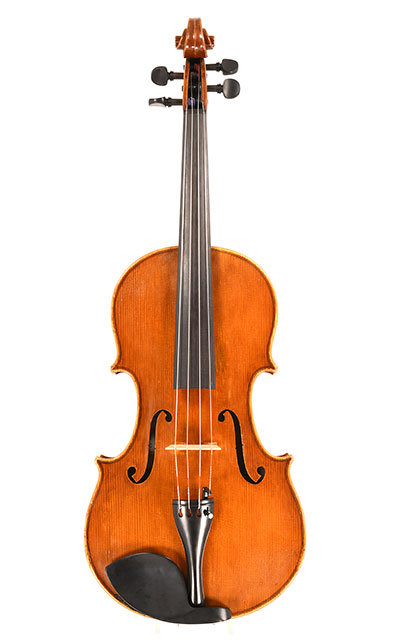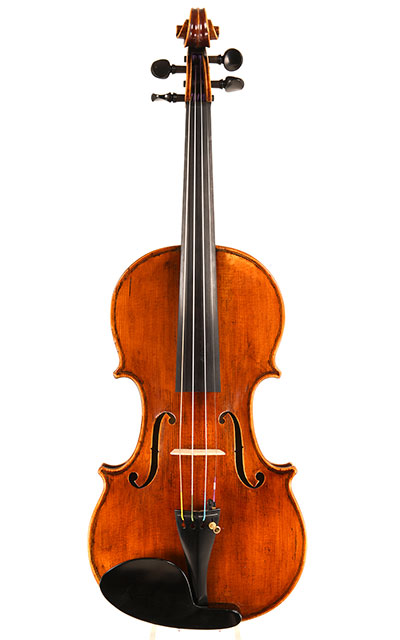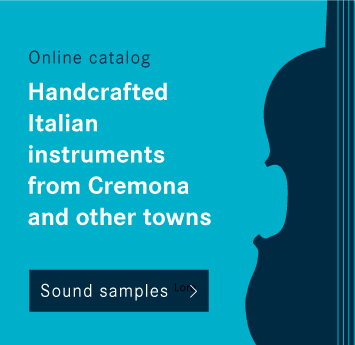Stradivaris heirs: contemporary Italian violin makers in Cremona
Five hundred years ago, the history of the violin began in Cremona. Which Cremona violin makers now work in Stradivari's hometown? With this selection of eight brief portraits, we present noteworthy Cremonese violin makers from the modern era.
Cremona is a city in Italy known for its renowned violin makers and violin-making tradition. Antonio Stradivari and Andrea Amati are two famous violin makers who originated from Cremona. Cremona violin makers have built some of the most famous instruments in the world throughout history, including the Stradivari, Guarneri, and Amati violins.Their meticulous attention to detail, adherence to time-honored techniques, and dedication to preserving the legacy of their predecessors result in instruments that are treasured by musicians and collectors worldwide. Italian violin makers are renowned worldwide for their exceptional skill and dedication to the art of violin making. Violins from Cremona are works of art that continue to inspire and captivate with their exceptional sound and timeless beauty.
In Cremona, where the violin's history began over a half a millennium ago, artisanal violin making has been undergoing a renaissance since the 1950s. After a two-hundred year period of decline in Cremona, numerous Cremona violin makers, new master ateliers, luthiers and student-teacher relationships with an international impact have bloomed around the international violin making school, and it is here that Italian Cremona violin making is being redefined.
The most important contemporary Cremona violin makers:
- Gio Batta Morassi
- Stefano Conia
- Francesco Bissolotti

- Marco Nolli
- Dante Fulvio Lazzari
- Maurizio Tadioli
- Massimo Ardoli
- Alessandro Voltini
- Mauro Lucini
- The legacy of Italian violin makers
Italian violin maker Giobatta Morassi
Giobatta Morassi – whose name was actually Giovanni Battista – is an Italian violin maker who came to Cremona at a time when the violin making school there had become irrelevant in a manner that is inconceivable today. Born in 1934 in Arta Terme, GioBatta Morassi initially attended a wood carving school in Camporosso, after which he decided to pursue violin making. When GioBatta Morassi arrived at the Cremona train station in 1950 and asked for directions to the violin making school, people could not help him at first, since at the time it was located in the auditorium of another university building and was more or less unknown. In the decades that followed, however, he and other significant masters from throughout Italy brought the Scuola di Liuteria into its current glory. GioBatta Morassi studied here under Peter Tatar until 1955 before becoming his assistant; later he began working for the school's first official maestro liutai, Pietro Sgarabotto. GioBatta Morassi eventually took the position himself in 1971. During his teaching career, which lasted until 1983, Morassi worked with a wide range of international students, some of whom launched outstanding careers here, and training under Morassi served as an excellent reference for his students. In parallel, he operated his own studio from 1959 on, and to this day it is still located on Via Lanaioli in Cremona. His son Simeone Morassi has taken it over in the meantime, a successful violin maker who has won awards in Mittenwald, Poznan and Cremona, among many others. Presentations and work as a juror in competitions have taken Cremona violin maker GioBatta Morassi to Russia, Poland and Japan. He is a co-founder of the Italian luthiers' association "Associazione Liuteria Italiana" (A. L. I.). His instruments are held in high regard by musicians all over the world.
Italian violin maker Stefano Conia
Although Italian violin maker Stefano Conia is not a native of Cremona, he was born in 1946 in Hungary, he has always had strong ties to Lombardy's international capital of violinmaking: his father, the luthier István Kónya, graduated from violin making school there. At the age of 44, Kónya left the Hungarian town of Tata for Cremona, returning to his native land after his training. He was also the one to give his son Stefano Conia violin lessons and introduce him to the art of hand-crafting instruments. Stefano earnestly followed in his father's footsteps and also studied in Cremona from 1968 to 1972. Under the tutelage of Cremonese masters Pietro Sgarabotto, Gio Batta Morassi and Francesco Bissolotti, Stefano Conia successfully honed his skills and decided to remain in Cremona after graduation. He married an Italian woman and Romanized his name. As an instructor at his alma mater, Stefano Conia went on to teach violin making students from across the globe for over twenty years. He also founded his own atelier which is now on Corso Garibaldi; there he makes instruments based on classic Italian patterns as well as his own designs. Stefano Conia has received many awards at national and international competitions, including a gold medal at the Cremonese Triennale in 1971. His instruments have been played by the Szabó Quartet, among others. He is a founding member of the Italian luthiers' association A. L. I. His son Stefano Conia, who is called "Junior," has also attained great acclaim as a violin maker. His achievements include winning the Walter Stauffer medal at the Triennale, and today he has a studio on Via San Giuseppe.
Francesco Bissolotti
Another great and internationally respected name among the artisans who shaped the history of Cremona's violin making history is Francesco Bissolotti. Born in 1929 in Soresina, he was originally a wood sculptor and intarsia craftsman who studied music and violin on the side, eventually becoming highly skilled as an amateur violinist. He attended the violin making school in Cremona under Pietro Sgarabotto, Giuseppe Ornati and Luigi Galimberti until 1961; beyond that, his deep friendship and close work with Simone Fernando Sacconi had an influence on his artistic development that would be difficult to overstate. Sacconi was the one who taught Francesco Bissolotti about using an inside mould in crafting instruments – a classic principle of Italian violin making which Stradivari strictly adhered to and which opened up a broad range of creative opportunities. Francesco Bissolotti was also a key figure in restructuring the Museo Stradivari in Cremona in conjunction with Sacconi. For over 20 years, Bissolotti taught at the city's violin making school, and much like Gio Batta Morassi, he played a fundamental part in its renaissance. At the same time, he also ran his own atelier at Piazza S. Paolo where he remains active, together with his four sons Marco Vinicio, Maurizio, Tiziano and Vincenzo. Although the entire family has always refrained from taking part in exhibitions or competitions for reasons of personal conviction, Bissolotti stringed instruments still enjoy an outstanding international reputation. Francesco Bissolotti created a customized five-string contraviola for the Italian violinist and conductor Salvatore Accardo, who then performed Niccolò Paganini's Sonata per la Gran Viola on it. Francesco Bissolotti has focused his work on imparting the old traditions of Cremonese violin making; it is with this thought in mind that he designed the exhibition "Classical Violin-Making, a Method," which was seen throughout Europe.
Cremona violin maker Marco Nolli
Born in 1964, Marco Nolli specialises in making upright basses. He acquired his violin making skills under Stefano Conia and Giorgio Scolari at the school in Cremona, graduating in 1983. He then received the opportunity to work for Scolari, who himself had studied under Gio Batta Morassi, and discover and refine his personal style. Scolari introduced Marco Nolli to the art of making upright basses. Since 1986, Nolli has had his own atelier where he offers multiple kinds of contemporary stringed instruments as well as reproductions and restorations.  Cremona violin maker Marco Nolli has enjoyed outstanding successes in national and international competitions, including several silver medals in Bagnacavallo and Baveno. His crowning achievement, however, was the gold medals his upright basses received at the Cremonese Triennale in 1988 and 2012. His instruments are in demand around the world; he has made pieces that are played by musicians at the Orchestra Filarmonica della Scala, the Beijing Symphony Orchestra, the Pittsburgh Symphony Orchestra, the St. Gallen Symphony Orchestra and the North German Radio Symphony Orchestra, to name only a few. Nolli's musicality was evident at a very early age, and he plays several instruments and works as a conductor as well. He shares his knowledge and experience with rising members of the guild at workshops and courses.
Cremona violin maker Marco Nolli has enjoyed outstanding successes in national and international competitions, including several silver medals in Bagnacavallo and Baveno. His crowning achievement, however, was the gold medals his upright basses received at the Cremonese Triennale in 1988 and 2012. His instruments are in demand around the world; he has made pieces that are played by musicians at the Orchestra Filarmonica della Scala, the Beijing Symphony Orchestra, the Pittsburgh Symphony Orchestra, the St. Gallen Symphony Orchestra and the North German Radio Symphony Orchestra, to name only a few. Nolli's musicality was evident at a very early age, and he plays several instruments and works as a conductor as well. He shares his knowledge and experience with rising members of the guild at workshops and courses.
Cremonese violin maker Dante Fulvio Lazzari
Italian violin maker Dante Fulvio Lazzari, a Cremonese native who was born in 1964, was accepted to the city's violin making school at the tender age of 13. His instructors were Primo Pistoni and Gio Batta Morassi. In parallel to his training, he also took a course in wood carving with Cremonese sculptor and luthier Piero Ferraroni. Lazzari completed his degree with honours in 1982 and began working for himself in the years that followed. He also took part in the first violin making competition held by the society of German luthiers and bow makers in Kassel in 1983. Beginning in 1985, Dante Fulvio Lazzari worked at the Via Aselli atelier of Marcello Ive. The exceptional talent he displayed even as a young man became unmistakable in the years that followed thanks to his triumphs in competitions: at the fourth Cremonese Triennale in 1985, he won a silver medal each in the categories of violin and cello as well as earning the Walter Stauffer gold medal as the best youth participant. At the 1986 Violin Society of America (VSA) competition in Portland, he received honorable mentions for a violin and a viola. His many successes extended to national contests as well, such as the violin making competition in Baveno in 1987, where Lazzari brought home a gold medal and a special award. His viola won first place in Cremona in 1988, followed by a silver medal for another viola at the International Violin Making Competition in Mittenwald in 1993. Since the mid-1990s, Dante Fulvio Lazzari has been working with the violin making school in Cremona as an instructor. His instruments have been sold to select clients in Europe, the US and China. He served as a juror at the eleventh Triennale in Cremona in 2006.
Cremona violin maker Maurizio Tadioli
Cremonese violin maker Maurizio Tadioli, who was born in 1967, came to know the art of instrument making as a child, thanks to his grandfather Carlo Pizzamiglio, an autodidact in violin making. Early on, Maurizio Tadioli started taking courses at the violin making school in Cremona, receiving top marks when he graduated in 1985 under Riccardo Bergonzi. Further training with Samuel Zygmuntowicz, Gregg Alf and Christian Bajon refined his expertise. His successes include multiple medals and very good rankings at competitions in Bagnacavallo, Baveno and Cremona. In 2004, Maurizio Tadioli received a Certificate of Merit for Tone for his quartet at the Violin Society of America (VSA) competition in Portland. Many exhibitions have featured his work, such as the the Shanghai Music Fair, Mondomusica in New York or the Musikmesse Frankfurt. A Baroque violin Maurizio Tadioli made in 1984 is now showcased at the museum of the international violin making school in Cremona.  In 2010, Maurizio Tadioli was invited to be on the jury of the international violin making competition in Pisogne. His designs are strongly oriented toward historic Cremonese instrument models, although they are also inspired by other traditions such as the Milanese school. For several years, Maurizio Tadioli held courses on varnishing instruments at the Cremonese violin making school. He currently lives in Cortetano, a small town near Cremona. Musicians and luthiers from the four corners of the world meet at his atelier; the many artists who play his instruments include the highly acclaimed Chinese violinist Yi-Jia Susanne Hou. Maurizio Tadioli accompanies many choirs and orchestral ensembles in and around Cremona as a pianist and organist.
In 2010, Maurizio Tadioli was invited to be on the jury of the international violin making competition in Pisogne. His designs are strongly oriented toward historic Cremonese instrument models, although they are also inspired by other traditions such as the Milanese school. For several years, Maurizio Tadioli held courses on varnishing instruments at the Cremonese violin making school. He currently lives in Cortetano, a small town near Cremona. Musicians and luthiers from the four corners of the world meet at his atelier; the many artists who play his instruments include the highly acclaimed Chinese violinist Yi-Jia Susanne Hou. Maurizio Tadioli accompanies many choirs and orchestral ensembles in and around Cremona as a pianist and organist.
Cremona violin maker Massimo Ardoli
Cremona violin maker Massimo Ardoli was born in 1962 in Cremona, and like his father, the luthier Angelo Ardoli, he also attended the violin making school there, studying under Gio Batta Morassi. He received his diploma in 1982 and then spent four years at Giorgio Scolari's atelier, where he refined his art by acquiring experience in restoring historic instruments whilst also developing skills in making new instruments. In 1991 Massimo Ardoli founded his own studio in Cremona. He patterns his work after both classic Italian templates and more contemporary ones, such as those of Giuseppe Ornati and Giuseppe Lucci. Massimo Ardoli's works have been presented at several different exhibitions and ranked very highly at competitions, including Baveno, Bagnacavallo, VSA contests and the Cremonese Triennale. Ardoli crafts stringed instruments of all kinds as well as repairing and replicating stringed instruments and Baroque plucked instruments. Since 1996, he has served as an instructor at the Cremona violin making school, where he is also responsible for the related Museo Organologico-Didattico. In 2010 he moved to a new atelier on Via Trecchi in the heart of Cremona, where he is joined by talented assistants. Massimo Ardoli was a member of the jury at the violin making competition in Pisogne in 2014.
Alessandro Voltini
His work as a master luthier in the rich Cremonese tradition is something that Cremonese violin maker Alessandro Voltini regards as a privilege and an exceptionally meaningful task. He upholds the tried-and-true design principles of historic patterns with painstaking care but also emphasizes the importance of developing a personal style. Both classic and major contemporary masters inform his work. Born in 1957 in Cremona, Alessandro Voltini finished his training at the town's violin making school in 1981. In the two years that followed, he worked in the restoration office of the musical-instrument collection of the Germanisches Nationalmuseum in Nuremberg under master Friedemann Hellwig. From 1983 to 1984 he worked in Lyon at Jean Schmitt's atelier specializing in restoration, where he had the opportunity to study a great number of famous instruments. He then established his own studio in Cremona. Alessandro Voltini has been teaching at a variety of venues since the 1980s, and since the year 2000 he has also done so at his own training center. There he is also responsible for maintaining the winning instruments obtained by the Fondazione Stradivari as part of the Triennale competitions, which he himself first took part in by entering a viola in 1988. That won him a silver medal, and the cello he submitted in 1994 earned him a gold medal. His students have also placed well at international contests. In 2001, 2003 and 2008, Alesssandro Voltini served as a juror at the competitions held at the violin making school in Queretaro, Mexico.
Mauro Lucini
Under the direction of Cremona violin maker Mauro Lucini - an experienced master craftsman who has been working as an independent violin maker in Cremona for decades - the highly skilled staff of the "Officina Mauro Lucini" make and refine Italian violins of outstanding musical and aesthetic quality in their workshop in Piazza San Michele. Italian violin maker Mauro Lucini and his journeymen are deeply familiar with the traditions of classical Cremonese violin making as cultivated at the renowned violin making school in the town of Antonio Stradivari. At the same time, a special openness to craft innovation and new approaches by contemporary masters characterizes their work, so that the atelier's new violins meet the high demands of its international clients and are distinguished by an unmistakable artistic profile. The workshop's repair work and restorations also benefit from this philosophy, for which the Officina Mauro Lucini has chosen an inspiring historic location in Cremona's old town, and not without reason: On the site of the medieval Hospital of St. John, just opposite the Basilica of San Michele, less than five minutes from the birthplace of Claudio Monteverdi.
Italian violin makers
Italian violin makers have built some of the most famous instruments in the world throughout history. These most famous masters of the craft created instruments that are revered for their superb tonal characteristics and overall excellence. The rich heritage of Italian violin making can be traced back to legendary makers such as Antonio Stradivari, Giuseppe Guarneri del Gesù, and Andrea Amati - highly sought-after instruments by musicians and collectors worldwide. The impact of these renowned Italian violin makers on the world of music cannot be overstated - their violins have been played by some of history's most notable musicians, setting the standard for all other violins to follow. Many talented but less known Italian violin makers are active today throughout Italy and produce violins in keeping the great tradition of Italian violin making.
Instruments by representative Italian violin makers:
- Fine violin by Mario Gadda
- Viola by Stefano Conia
- Fine violin by Daniele Scolari, Cremona
- Cremona violins including works by upcoming junior violin makers in Cremona
Library:
Cremona: the early Lombard history of Italian violin making
International violin making competitions -- an overview
Eric Blot, expert of Cremona and Italian violin making
Mirecourt's new masters: contemporary violin makers in Mirecourt
Contemporary violin makers from China and Taiwan
Today's violin makers - the modern artisans








